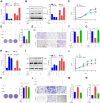hTERT Promotes CRC Proliferation and Migration by Recruiting YBX1 to Increase NRF2 Expression
- PMID: 34079797
- PMCID: PMC8165255
- DOI: 10.3389/fcell.2021.658101
hTERT Promotes CRC Proliferation and Migration by Recruiting YBX1 to Increase NRF2 Expression
Abstract
High human telomerase reverse transcriptase (hTERT) expression is related to severe Colorectal Cancer (CRC) progression and negatively related to CRC patient survival. Previous studies have revealed that hTERT can reduce cancer cellular reactive oxygen species (ROS) levels and accelerate cancer progression; however, the mechanism remains poorly understood. NFE2-related factor 2 (NRF2) is a molecule that plays a significant role in regulating cellular ROS homeostasis, but whether there is a correlation between hTERT and NRF2 remains unclear. Here, we showed that hTERT increases CRC proliferation and migration by inducing NRF2 upregulation. We further found that hTERT increases NRF2 expression at both the mRNA and protein levels. Our data also revealed that hTERT primarily upregulates NRF2 by increasing NRF2 promoter activity rather than by regulating NRF2 mRNA or protein stability. Using DNA pull-down/MS analysis, we found that hTERT can recruit YBX1 to upregulate NRF2 promoter activity. We also found that hTERT/YBX1 may localize to the P2 region of the NRF2 promoter. Taken together, our results demonstrate that hTERT facilitates CRC proliferation and migration by upregulating NRF2 expression through the recruitment of the transcription factor YBX1 to activate the NRF2 promoter. These results provide a new theoretical basis for CRC treatment.
Keywords: NRF2; YBX1; colorectal cancer; hTERT; progression.
Copyright © 2021 Gong, Yang, Wang, Liu, Li, Hu, Chen, Huang, Luo, Wu, Liu and Xiao.
Conflict of interest statement
The authors declare that the research was conducted in the absence of any commercial or financial relationships that could be construed as a potential conflict of interest.
Figures







Similar articles
-
SPT6 recruits SND1 to co-activate human telomerase reverse transcriptase to promote colon cancer progression.Mol Oncol. 2021 Apr;15(4):1180-1202. doi: 10.1002/1878-0261.12878. Epub 2021 Jan 12. Mol Oncol. 2021. PMID: 33305480 Free PMC article.
-
Keratin 23 promotes telomerase reverse transcriptase expression and human colorectal cancer growth.Cell Death Dis. 2017 Jul 27;8(7):e2961. doi: 10.1038/cddis.2017.339. Cell Death Dis. 2017. PMID: 28749462 Free PMC article.
-
CDC5L Promotes hTERT Expression and Colorectal Tumor Growth.Cell Physiol Biochem. 2017;41(6):2475-2488. doi: 10.1159/000475916. Epub 2017 May 4. Cell Physiol Biochem. 2017. PMID: 28472785
-
Study of the role of telomerase in colorectal cancer: preliminary report and literature review.G Chir. 2017 Sep-Oct;38(5):213-218. doi: 10.11138/gchir/2017.38.5.213. G Chir. 2017. PMID: 29280699 Free PMC article. Review.
-
Essential roles of telomerase reverse transcriptase hTERT in cancer stemness and metastasis.FEBS Lett. 2018 Jun;592(12):2023-2031. doi: 10.1002/1873-3468.13084. Epub 2018 May 18. FEBS Lett. 2018. PMID: 29749098 Review.
Cited by
-
Exploiting the DNA Damaging Activity of Liposomal Low Dose Cytarabine for Cancer Immunotherapy.Pharmaceutics. 2022 Dec 3;14(12):2710. doi: 10.3390/pharmaceutics14122710. Pharmaceutics. 2022. PMID: 36559204 Free PMC article.
-
YBX1: an RNA/DNA-binding protein that affects disease progression.Front Oncol. 2025 Jul 29;15:1635209. doi: 10.3389/fonc.2025.1635209. eCollection 2025. Front Oncol. 2025. PMID: 40799245 Free PMC article. Review.
-
NRF2 signaling pathway and telomere length in aging and age-related diseases.Mol Cell Biochem. 2024 Oct;479(10):2597-2613. doi: 10.1007/s11010-023-04878-x. Epub 2023 Nov 2. Mol Cell Biochem. 2024. PMID: 37917279 Free PMC article. Review.
-
Oxidative Stress, Inflammation and Colorectal Cancer: An Overview.Antioxidants (Basel). 2023 Apr 9;12(4):901. doi: 10.3390/antiox12040901. Antioxidants (Basel). 2023. PMID: 37107276 Free PMC article. Review.
-
LINC02167 stabilizes KSR1 mRNA in an m5C-dependent manner to regulate the ERK/MAPK signaling pathway and promotes colorectal cancer metastasis.J Exp Clin Cancer Res. 2025 Apr 15;44(1):121. doi: 10.1186/s13046-025-03368-w. J Exp Clin Cancer Res. 2025. PMID: 40234937 Free PMC article.
References
-
- Ge W., Zhao K., Wang X., Li H., Yu M., He M., et al. (2017). iASPP Is an Antioxidative Factor and Drives Cancer Growth and Drug Resistance by Competing with Nrf2 for Keap1 Binding. Cancer Cell 32 56:e566. - PubMed
LinkOut - more resources
Full Text Sources

